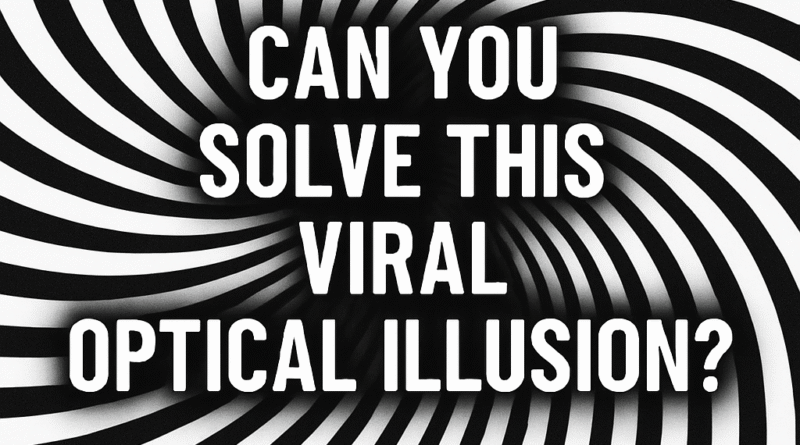This Optical Illusion Is Breaking the Internet – Can You Solve It?
This Optical Illusion Is Breaking the Internet – Can You Solve It?
Introduction
Optical illusions have captivated humans for centuries, playing tricks on our minds and challenging our perception of reality. In 2025, a new optical illusion has taken social media by storm, captivating millions around the world. This viral image isn’t just entertaining—it tests how our brain processes visual information, revealing surprising quirks about human perception. But can you solve it? This article will dive deep into the illusion, explore why it’s so challenging, and share tips on how to perceive it accurately.
What Is an Optical Illusion?
An optical illusion is a visual phenomenon where what we see conflicts with physical reality. It occurs when the information received by our eyes is interpreted by our brains in a way that differs from the actual stimulus. Our brains constantly try to make sense of ambiguous or incomplete visual cues by filling in gaps, making assumptions, or prioritizing certain elements over others. Illusions expose these shortcuts and assumptions, helping us understand the complex workings of the brain.
There are many types of optical illusions, including literal illusions (where the image differs from reality), physiological illusions (caused by excessive stimulation of specific neurons), and cognitive illusions (involving higher-level brain processes).
The Viral Illusion: What Makes It So Challenging?
The viral illusion that is captivating the internet in 2025 features a complex mix of shapes, colors, and patterns that appear to shift, move, or hide secret images. At first glance, viewers might see one thing, but after focusing or changing perspective, the image seems to transform. Some report seeing impossible objects, hidden faces, or dynamic motion within the still image.
Its creator designed it deliberately to exploit the brain’s visual processing system, creating confusion and forcing viewers to question their perception. This illusion belongs to a class called “ambiguous images” where two or more interpretations compete for attention.
What adds to the challenge is the use of contrasting colors, gradients, and strategic alignment of shapes to create “illusory contours” — edges or lines that don’t actually exist but are perceived by the brain.
The Science Behind the Illusion
To understand why this illusion is so effective, we need to delve into how our brains interpret visual stimuli. Our visual system is wired to detect edges, contrasts, and patterns quickly to recognize objects and make sense of the environment. When an image contains conflicting cues or ambiguous shapes, the brain tries to reconcile the information by switching between different possible interpretations.
For example, the famous “Rubin’s Vase” illusion can be seen as either a vase or two faces in profile, depending on what the brain focuses on. Similarly, the viral illusion in 2025 causes viewers to switch between multiple perceptions, making it difficult to settle on a single interpretation.
Furthermore, motion illusions occur when static images trick the brain into perceiving movement. This happens because of small changes in color gradients and spatial frequency, activating neurons sensitive to motion.
Why Are Optical Illusions So Fascinating?
Optical illusions provide insight into how our minds work. They remind us that perception is not a direct window to reality but a subjective interpretation shaped by past experiences, context, and expectations. This fascinates scientists, artists, and the general public alike.
Psychologists use illusions to study visual perception and cognitive processes, which can also inform research on neurological conditions such as schizophrenia, autism, and brain injuries. For everyday people, illusions are a source of entertainment and mental challenge.
Many artists incorporate illusions into their work to create stunning visuals that challenge viewers’ perspectives, like the famous works of M.C. Escher.
Tips to Solve the Illusion
If you want to try solving the viral optical illusion, here are some tips:
- Change your viewing distance: Step back or move closer to the image. Sometimes different details become clearer at different distances.
- Shift your focus: Look at different parts of the image rather than focusing on the center.
- Use peripheral vision: Sometimes what you perceive at the edges of your vision differs from what you see directly.
- Relax your eyes: Don’t strain; a soft focus can help reveal hidden shapes or movement.
- Take breaks: If the image is confusing, look away and return after a moment.
Trying these methods often helps viewers “flip” their perception and see the multiple interpretations hidden in the illusion.
Optical Illusions in Daily Life and Technology
Beyond entertainment, optical illusions have practical uses. They inspire design in architecture, advertising, and art by creating striking visual effects. In technology, understanding illusions aids in developing better virtual reality experiences, improving user interfaces, and enhancing computer vision algorithms.
Medical research uses illusions to diagnose and understand brain disorders affecting visual perception. For example, studying how patients perceive illusions can help identify damage to specific brain areas.
Popular Optical Illusions and Their Impact
Some illusions have become cultural phenomena, such as the “Café Wall” illusion, where parallel lines appear slanted, or the “Checker Shadow” illusion, which shows identical colors appearing different due to surrounding shadows.
These illusions highlight the brain’s incredible ability to interpret complex scenes but also reveal its vulnerabilities to misinterpretation.
Viral illusions like the one trending in 2025 continue this tradition, capturing imaginations and sparking curiosity worldwide.
Conclusion
The viral optical illusion breaking the internet in 2025 is more than just a captivating puzzle; it is a glimpse into the complex nature of human perception. By challenging your brain with such illusions, you gain insight into how your mind constructs reality from sensory input.
Whether you solve it quickly or find it perplexing, the experience sharpens your observational skills and encourages you to question what you see. Share this illusion with your friends and family to see who can uncover its secrets first!

